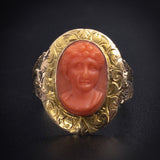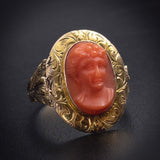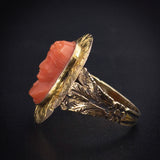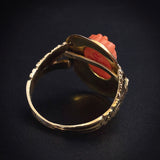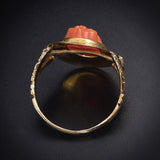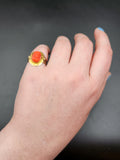A cameo is a form of glyptography, or bas-relief carving, most often cut into glass, hard-stones, and shells. Artworks were crafted to create two layers on one piece of material, the top of which protruded from its background, creating a multi-dimensional artwork. These detailed reliefs were often used to adorn pieces of jewelry, including brooches, necklaces, bracelets and rings. The earliest cameos took inspiration from prehistoric petroglyphs, which documented important religious and symbolic iconography onto rock faces.
Despite its popularity in previous periods, the most well-known era for cameo collection was the 19th century, inspired by royal cameo collectors Queen Victoria and Emperor Napoleon Buonaparte. Shelled cameos, which depicted these natural and humanistic scenes onto deep-sea shells, became quite popular under Queen Victoria’s reign. Similarly, Napoleon himself founded a Parisian apprentice school to foster the talents of young cameo carvers. *
The beautiful cameo in this case is carved from a bright orange coral, in amazingly realistic detail. With a straightforward expression on her face and baubles in her upswept hair, she has the air of a sophisticated lady of the ton, the higher echelon of the British social class during the 18th and 19th centuries. Converted from a Victorian brooch and converted to a ring with a gorgeous replica shank, this cameo ring is like wearing a little story from a bygone era on your hand.
* Source: My Modern Met https://mymodernmet.com/history-of-cameo-jewelry
Details (approximate)
Size (can be resized): 8
Weight: 2.8 grams
Materials: Gold, Carved coral cameo
Metal: 14K yellow gold (shank), 10K yellow gold (ring top)
Marks: None
Condition: Very good converted antique condition commensurate with age.
LOE






